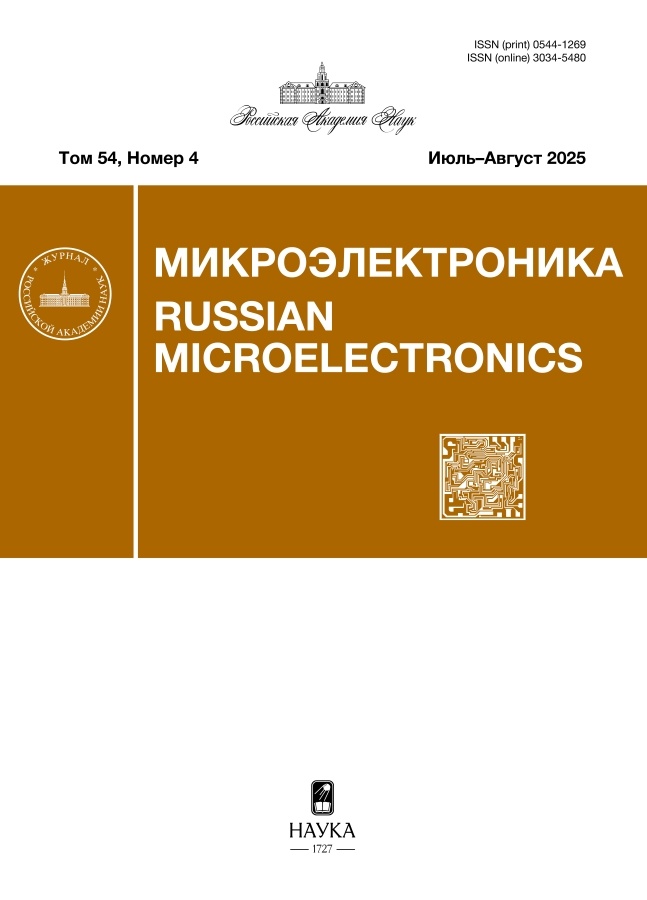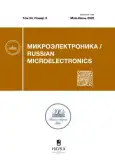Структура тонких пленок нитрида титана, сформированных методом магнетронного распыления
- Авторы: Исаев А.Г.1, Рогожин А.Е.1
-
Учреждения:
- НИЦ “Курчатовский институт”
- Выпуск: Том 54, № 3 (2025)
- Страницы: 202-212
- Раздел: ДИАГНОСТИКА
- URL: https://gynecology.orscience.ru/0544-1269/article/view/689382
- DOI: https://doi.org/10.31857/S0544126925030029
- EDN: https://elibrary.ru/PWNPMT
- ID: 689382
Цитировать
Полный текст
Аннотация
Эта обзорная статья посвящена структуре тонких пленок нитрида титана, сформированных методом магнетронного распыления. Рассмотрена модель роста пленок в зависимости от температуры осаждения и потока азота. Проведено сравнение модели с экспериментальными результатами. Описано влияние отжигов на структуру пленок магнетронного нитрида титана.
Ключевые слова
Полный текст
Об авторах
А. Г. Исаев
НИЦ “Курчатовский институт”
Автор, ответственный за переписку.
Email: isaev.ag@phystech.edu
Россия, Москва
А. Е. Рогожин
НИЦ “Курчатовский институт”
Email: isaev.ag@phystech.edu
Россия, Москва
Список литературы
- Sharath S.U., Vogel S., Molina-Luna L. Control of Switching Modes and Conductance Quantization in Oxygen Engineered HfOx based Memristive Devices // Adv. Funct. Mater. 2017. Vol. 27. № 32. P. 1700432.
- Isaev A.G., Permyakova O. О., Rogozhin A.Е. Mechanisms of conductive filament formation in hafnium oxide multilayer structures // Thin Solid Films. 2023. Vol. 781. P. 139993.
- Isaev A.G., Permyakova O.O., Rogozhin A.E. Oxide Memristors for ReRAM: Approaches, Characteristics, and Structures // Russ. Microelectron. 2023. Vol. 52. № 2. P. 74–98.
- Kohlhase A., Mändl M., Pamler W. Performance and failure mechanisms of TiN diffusion barrier layers in submicron devices // J. Appl. Phys. 1989. Vol. 65, № 6. P. 2464–2469.
- Kwak M.Y., Shin D.H., Kang T.W., Kim K.N. Characteristics of TiN barrier layer against Cu diffusion // Thin Solid Films. 1999. Vol. 339. № 1–2. P. 290–293.
- Vorobjova A.I., Labunov V.A., Outkina E.A., Grapov D.V. Metallization of Vias in Silicon Wafers to Produce Three-Dimensional Microstructures // Russ. Microelectron. 2021. Vol. 50. № 1. P. 8–18.
- Huang J.S., Oates A.S., Zhao J. Effect of cracks in TiN anti-reflection coating layers on early via electromigration failure // Thin Solid Films. 2000. Vol. 371. № 1–2. P. 310–315.
- Pan F., Gao S., Chen C. Recent progress in resistive random access memories: Materials, switching mechanisms, and performance // Mater. Sci. Eng. R Rep. 2014. Vol. 83. P. 1–59.
- Lanza M., Wong H.-S.P., Pop E. Recommended Methods to Study Resistive Switching Devices // Adv. Electron. Mater. 2019. Vol. 5. № 1. P. 1800143.
- Kajikawa Y., Noda S., Komiyama H. Comprehensive perspective on the mechanism of preferred orientation in reactive-sputter-deposited nitrides // J. Vac. Sci. Technol. Vac. Surf. Films. 2003. Vol. 21. № 6. P. 1943–1954.
- Patsalas P., Kalfagiannis N., Kassavetis S., Abadias G., Bellas D.V., Lekka Ch., Lidorikis E. Conductive nitrides: Growth principles, optical and electronic properties, and their perspectives in photonics and plasmonics // Mater. Sci. Eng. R Rep. 2018. Vol. 123. P. 1–55.
- Petrov I., Barna P.B., Hultman L., Greene J.E. Microstructural evolution during film growth // J. Vac. Sci. Technol. Vac. Surf. Films. 2003. Vol. 21. № 5. P. S117–S128.
- Mahieu S., Depla D., Gryse R.D. Modelling the growth of transition metal nitrides // J. Phys. Conf. Ser. 2008. Vol. 100. № 8. P. 082003.
- Mahieu S., Depla D. Reactive sputter deposition of TiN layers: modelling the growth by characterization of particle fluxes towards the substrate // J. Phys. Appl. Phys. 2009. Vol. 42. № 5. P. 053002.
- Mahieu S., Ghekiere P., Depla D., De Gryse R. Biaxial alignment in sputter deposited thin films // Thin Solid Films. 2006. Vol. 515. № 4. P. 1229–1249.
- Matacotta F.C., Ottaviani G. Science and technology of thin films. Singapore New Jersey London [etc.]: World scientific, 1995.
- Thornton J.A. High Rate Thick Film Growth // Annu. Rev. Mater. Sci. 1977. Vol. 7. № 1. P. 239–260.
- Li T.Q., Noda S., Tsuji Y., Ohsawa T., Komiyama H. Initial growth and texture formation during reactive magnetron sputtering of TiN on Si(111) // J. Vac. Sci. Technol. Vac. Surf. Films. 2002. Vol. 20. № 3. P. 583–588.
- Martinez G., Shutthanandan V., Thevuthasan S., Chessa J.F., Ramana C.V. Effect of thickness on the structure, composition and properties of titanium nitride nano-coatings // Ceram. Int. 2014. Vol. 40. № 4. P. 5757–5764.
- Yang H.H., Je J.H., Lee K.-B. Effect of the nitrogen partial pressure on the preferred orientation of TiN thin films // J. Mater. Sci. Lett. 1995. Vol. 14. № 23. P. 1635–1637.
- Je J.H., Noh D.Y., Kim H.K., Liang K.S. The crossover of preferred orientation in TiN film growth: A real time x-ray scattering study // J. Mater. Res. 1997. Vol. 12. № 1. P. 9–12.
- Zhou T., Liu D., Zhang Y., Ouyang T., Suo J. Microstructure and hydrogen impermeability of titanium nitride thin films deposited by direct current reactive magnetron sputtering // J. Alloys Compd. 2016. Vol. 688. P. 44–50.
- Chuang K.-L., Tsai M.-T., Lu F.-H. Morphology control of conductive TiN films produced by air-based magnetron sputtering // Surf. Coat. Technol. 2018. Vol. 350. P. 1091–1097.
- Huang J.-H., Yu K.-J., Sit P., Yu G.-P. Heat treatment of nanocrystalline TiN films deposited by unbalanced magnetron sputtering // Surf. Coat. Technol. 2006. Vol. 200. № 14–15. P. 4291–4299.
- Xi Y., Fan H., Liu W. The effect of annealing treatment on microstructure and properties of TiN films prepared by unbalanced magnetron sputtering // J. Alloys Compd. 2010. Vol. 496. № 1–2. P. 695–698.
- Kavitha A., Kannan R., Sreedhara Reddy P., Rajashabala S. The effect of annealing on the structural, optical and electrical properties of Titanium Nitride (TiN) thin films prepared by DC magnetron sputtering with supported discharge // J. Mater. Sci. Mater. Electron. 2016. Vol. 27. № 10. P. 10427–10434.
- Ghailane A. et al. Influence of Annealing Temperature on the Microstructure and Hardness of TiN Coatings Deposited by High-Power Impulse Magnetron Sputtering // J. Mater. Eng. Perform. 2022. Vol. 31. № 7. P. 5593–5601.
Дополнительные файлы
Доп. файлы
Действие
1.
JATS XML
2.
Рис. 1. Схематическое изображение изменения структуры пленки при изменении температуры подложки (Ts) по отношению к температуре плавления осаждаемого материала (Tm) или потока частиц газа (Jgas) по отношению к потоку частиц мишени (Jtar) согласно РСЗ-модели [12]
Скачать (18KB)
Скачать (22KB)
4.
Рис. 3. Схематическое изображение процесса роста и итоговой структуры пленок, полученных в условиях зоны Ic [15]
Скачать (14KB)
5.
Рис. 4. Схематическое изображение процесса роста и итоговой структуры пленок, полученных в условиях зоны T [15]
Скачать (15KB)
Скачать (5KB)
7.
Рис. 6. Ориентация пленок и РЭМ-изображения поверхности пленок при различных потоках азота в процессе распыления [15]
Скачать (32KB)
8.
Рис. 7. Модель изменения структуры пленки TiN в процессе роста: (а–г) схематическое представление изменения структуры пленки TiN в процессе роста; (д–ж) изображения ПЭМ; (з, и) спектры РСА, подтверждающие модель [18]
Скачать (80KB)
9.
Рис. 8. Влияние потока азота на структуру пленки TiN на танталовой подложке: (а–в) РЭМ-изображения поверхности пленок, полученных при различных потоках азота; зависимость среднего размера зерен (г) и ориентации пленки (д) от величины потока азота [22]
Скачать (64KB)
10.
Рис. 9. Структура пленок TiN при использовании смеси N2 /O2 в качестве реактивного газа: (а) РЭМ-изображения пленок, полученных при различных потоках реактивного газа; влияние потока реактивного газа на РСА спектры (б) и ориентацию пленки (в) [23]
Скачать (43KB)
11.
Рис. 10. Влияние отжигов в атмосфере Ar/H2 на структуру пленок TiN: РЭМ-изображения неотожженной (а) и отожженной при 700 °С (б) пленки; РСА спектры пленок с различной температурой отжига (в); ориентация (г) и шероховатость (д) поверхности пленок в зависимости от температуры отжига и толщины [24]
Скачать (40KB)
12.
Рис. 11. РЭМ-изображения поверхности пленок TiN после отжига при различных температурах: а) неотожженная пленка; б) 300 °C; в) 450 °C; г) 700 °C; д) 900 °C [25]
Скачать (60KB)
13.
Рис. 12. Влияние низкотемпературных отжигов на структуру пленок TiN: АСМ изображения поверхности неотожженной пленки (а) и пленок, отожжённых при 100 °С (б), 200 °С (в), 300 °С (г); РСА спектры и шероховатость пленки (д) при различных температурах отжига [26]
Скачать (55KB)
14.
Рис. 13. Влияние температуры отжигов HiPIMS пленок на ориентацию (а), средний размер зерен (б) и шероховатость (в) пленки [27]
Скачать (21KB)





















